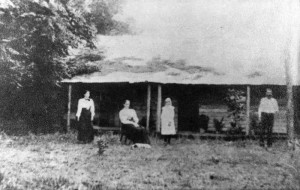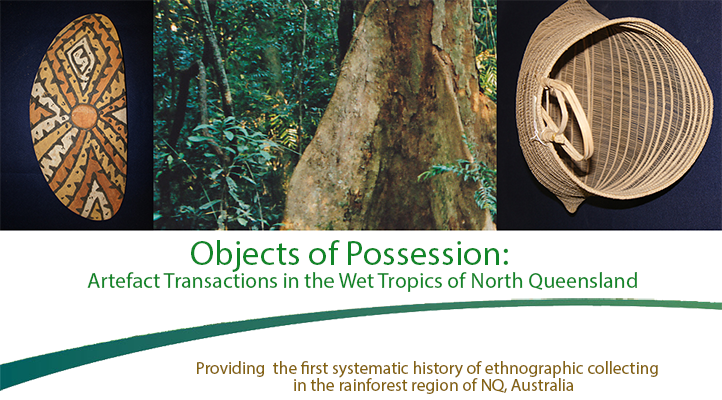Author: Trish Barnard
Collector: Gladys Jean Henry
Born: 1921.
Died: 2010.
Active: Gladys Henry collected in the Cardwell-Tully region from the 1950s to the 1980s.
Background biography:
Gladys Henry understood the urgency of the need to collect material culture produced by Jirrbal, Girramay and Gulnay people in the traditional manner while the younger members of these groups still had access to the knowledge of the Elders, thus ensuring cultural continuity. For that, she is still honoured today by members of these Aboriginal groups.
Gladys was one of nine children born to George and Ivy Ellen Rodger (nee Jenkins) from Millaa Millaa. She spent her childhood at Midgenoo near Tully, and was schooled at Blackheath College in Charters Towers. In 1941 she married George Dudley Henry (1918-1985), grandson of Isaac Henry (c.1833-1922) who arrived in Tully in 1879, becoming the district’s first permanent white settler. Isaac’s wife Barbara arrived in 1881 and they settled on 2048ha of leased land in the Bellenden Plains area on the Murray River about 32km north of Cardwell. They called their property ‘Riversdale’. The Henrys intended to grow sugar cane, but also cultivated citrus fruits and other small crops and eventually ran cattle. They built a modest home and raised their five children. Their eldest son William built a large nine room home on Bellenden Plains just south of the Murray River but after he died of typhoid fever aged only 30, his siblings continued to occupy the homestead and manage the property.
From 1908, William’s brother Brice (1877-1940) lived at nearby Wingfield on the Murray River with his wife Jean Justine Caldersmith. They too had five children. Isaac passed away in 1922 and his wife Barbara died seven years later. Both were buried nearby at Murrigal, and family members continued to manage the Bellenden property. Brice’s sisters, Barbara and Elizabeth, moved to Cairns where they established St Luke’s Private Hospital. Barbara returned to the Bellenden Homestead in 1930 and later married Englishman, William Sparvell, but they later retired to another property near Bellenden. Jean Justine also stayed on and managed the Riversdale property after Brice died in 1940. She continued the family’s commitment to working with the local Jirrbal, Girramay and Gulnay people in the Davidson Creek area, who often came down to camp by the river in the dry season when they were looking for work. The local people were fast losing their traditional hunting grounds to farming and were often displaced to other areas.
Entries in the Cardwell Police Letterbook for May 1933 show that Barbara Sparvell employed local man Charlie Barney on her property to prevent him being sent to a reserve or mission. Her nephew’s wife, Gladys shared her passion for local Aboriginal culture. Gladys and her husband George established a farm on nearby reaches of the Tully River at Glen Tyson where they raised their family of six children. For many years Jean Justine, Barbara and Gladys collected material culture from the Jirrbal people and the neighbouring Girramay people around Cardwell and the Gulnay people along the Tully River. Gladys encouraged the Jirrbal, Girramay and Gulnay people to make artefacts such as bicornual baskets, bags, eel traps and boomerangs and despite her very limited financial resources at the time, she purchased many artefacts. Her daughter Valerie Keenan, now the Art Centre Manager at Girringun Aboriginal Corporation in Cardwell, has fond memories of the variety of unique artefacts at the family home.
Gladys and George eventually moved into the Bellenden homestead on the Henry cattle property after their Glen Tyson home was destroyed in a fire. Gladys was an avid gardener and adored her orchids. She also took an interest in art and was proficient in landscape and portrait drawings. At Bellenden, Gladys continued to work closely with the Jirrbal, Girramay and Gulnay people and listened to their concerns that their traditional culture was disappearing with increased settlement and farming. She began documenting their traditional stories passed down over many generations and in 1967 published a book entitled Girroo Gurrll the First Surveyor and Other Aboriginal Legends. She spent many hours with elderly Malanbara men from Gordonvale, particularly Joe Challum (b.c.1892) and Joe Kinjun, also Paddy Beeron of the Girramay people and Chloe Grant of the Jirrbal people, listening to stories about their lives and traditional times. Gladys had a reputation for warmth and friendliness and many Aboriginal people lived at small camps on the Bellenden property. According to linguist Bob Dixon, Challam told other visitors and linguists working in the area about the ‘white woman living up the road who was writing a book about the local legends and place names’.
Gladys went to great lengths to verify each story and travelled through swamps and dense forests with members of the Jirrbal, Girramay and Gulnay people to gain a full understanding and appreciation of their country and cultural sites. She waded through swamps to the Warrami waterhole, inland from Euramo and abundant with birdlife, to learn about an important ancestral story about Marngull the Nankeen Night Heron that turned to rock and can be still seen there. She did all the pen and ink drawings for the book, and worked with Warroon (Tommy Sullivan) who did the red ochres drawings. In the book she provided a very detailed map of their country and story places and documented language words such as Goonghurrah for Glen Tyson where she and George had their original home.
Eventually, Gladys placed a sign on the highway and opened an outlet at the Bellenden Homestead for the Jirrbal, Girramay and Gulnay people to sell their artefacts, providing them with a modest income. This also helped them to maintain their ‘traditional’ skills at a time when most Aboriginal people were being displaced to reserves and missions and losing their connection to culture. In a letter to the Australia Council, Professor Barrie Reynolds described the outlet as an ‘open grass walled [bamboo] shed [with a concrete floor] on the Henry property close to Murray Upper’. All that remains is the concrete slab but many elderly Jirrbal, Girramay and Gulnay people still remember her fondly and appreciate her support for cultural activities and skills.
Reynolds stated that the ‘strength of the Henry collection is that it is probably the last documentable collection from the rainforest’ and acknowledged that it was the ‘only private collection of any size’ which included stone tools, baskets, shields and the unique Bagu and Jiman fire makers. He also mentioned that the collection included ‘30-40 pieces that are of particular age and historical value’.
These objects also hold personal value and community members often visit the Museum of Tropical Queensland, where most of the Henry collection is now held, to reconnect with material culture made by previous generations. It is an emotional time and there is a dual sense of respect for both the skills executed by the makers and the foresight Gladys showed in ensuring that generations of traditional makers would be represented and their material culture made accessible to future families. In 2012 members of the Beeron family from Murray Upper travelled to Townsville and were in awe of the meticulous expertise that Daisy Denham had for weaving the traditional bicornual baskets. These skills have been passed down from Daisy to her daughters, Nancy (b.1949) and Theresa (b.1951) who continue to make these unique baskets at the Art Centre of the Girringun Aboriginal Corporation. Theresa’s son Daniel is also a skilled weaver but prefers to carve message sticks and fire makers traditionally made by Jirrbal, Girramay and Gulnay men.
In 1979 Gladys sold the collection of 588 artefacts to the Aboriginal Arts Board of the Australia Council for $5,800. The board deposited the collection with the Material Culture Unit at James Cook University, to whom the Australia Council gifted the collection in 1989. This gesture was celebrated with an official handover on 10 April 1990 attended by dignitaries from both organisations, Gladys Henry and local traditional owner representatives, and with performances by Waddama Dancers. The collection is still one of the most important to be assembled since Walter Roth collected in the Cardwell-Tully region in the early 1900s, and contains excellent examples of material culture production that continued well into the 1970s. Some of Gladys Henry’s collection is also held at the National Museum of Australia in Canberra.
Gladys Henry left an outstanding legacy and a remarkable contribution to the community as the first female councillor elected to the Cardwell Shire Council from 1976 to 1982. The Henry family have established a reputation for being exceptional and were honoured in 2009 with the ‘Henry Family Bridge’ on the Bruce Highway over the Murray River, named as part of the Q150 celebrations. The Tully State High School commemorates her with the Gladys Henry Art Award in the Department of Arts for students of outstanding ability. Many fourth and fifth generation members of this remarkable family continue to work on the land and pursue other vocations in the Tully region and are proud of their heritage.
Sources cited:
Cardwell Police Letterbook, http://www.cifhs.com/qldrecords/qldcardwell.html

‘Mr Isaac Henry, aged 57, and his family in front of the Bellenden Homestead, ca. 1899’, Image: George and Gladys Henry collection courtesy Valerie Keenan, Cardwell.
Dixon, Bob. Searching for Aboriginal Languages: Memoirs of a Field Worker, University of Queensland Press, St Lucia, 1983.
Letter dated 17 November 1978 from Professor Barrie Reynolds, James Cook University, to Mr Robert Edwards, Director, Aboriginal Arts Board, Australia Council.
